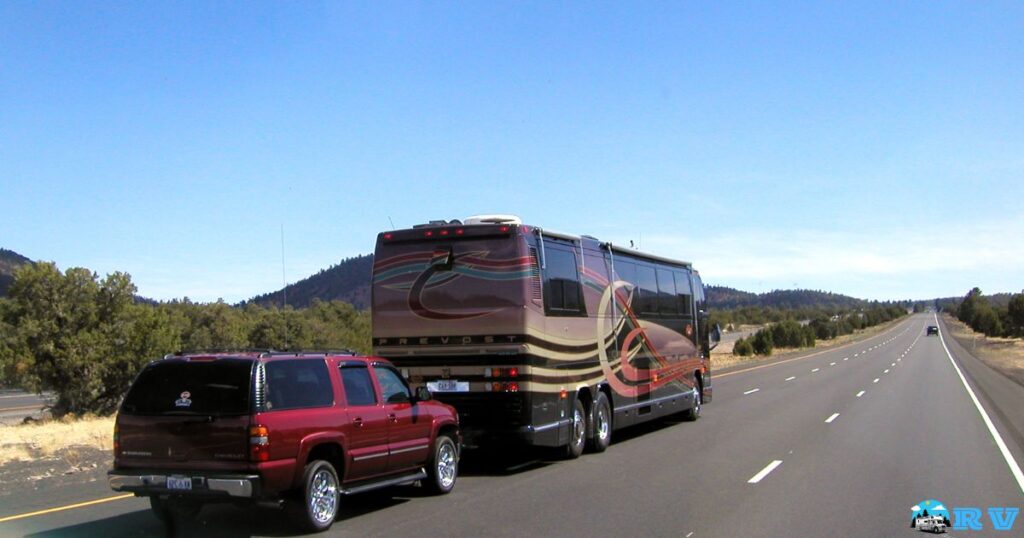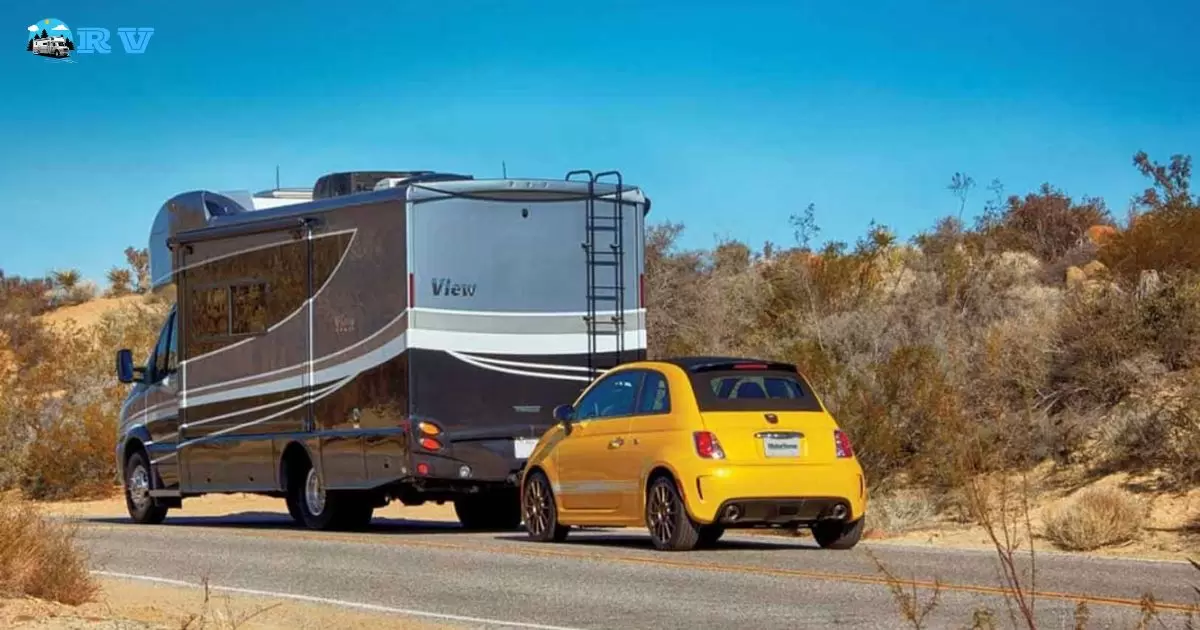Towing a car with an RV involves attaching a vehicle to the back of a recreational vehicle using a specific set of equipment and following safety protocols. This process allows RV travelers to have a smaller vehicle for use at their destination. The key components include a tow bar, baseplate, and safety cables.
Have you ever wondered about the freedom of traveling in an RV while still having the convenience of a car at your destination? The question how to tow a car with an RV? opens up a world of possibilities for RV enthusiasts. This method is a game-changer for making the most out of road trips.
When you tow a car with an RV, it’s essential to understand the types of towing methods available, such as flat towing or using a tow dolly. Each method has its advantages and requirements. It’s crucial to be aware of the towing capacity of your RV and the legal requirements for towing in different regions.
Understanding the Basics of RV Car Towing
Towing a car with an RV is a practical solution for those wanting the comfort of their RV and the convenience of a smaller vehicle. This method, often referred to as ‘dinghy towing,’ allows RV travelers to easily navigate urban areas or make quick trips without moving their RV.
The process involves attaching a car to the rear of an RV using a tow bar, safety cables, and sometimes additional braking systems. Understanding the weight capacities of both your RV and the car is crucial. It’s important to ensure that the RV is capable of towing the additional weight safely.
Before starting, familiarize yourself with the different types of towing setups and their respective equipment. This includes understanding the differences between flat towing, where all four wheels of the car are on the ground, and using a tow dolly, where the car’s front wheels are elevated.
Choosing the Right Towing Equipment for Your RV
Selecting the correct towing equipment is critical for the safety and efficiency of your journey. The primary piece of equipment needed is a tow bar, which connects the RV to the car. Tow bars come in various designs, such as A-frame or self-aligning, each with its advantages.
Choosing a tow bar that matches the weight of your car and the towing capacity of your RV is essential. Additionally, consider ease of use and storage when selecting a tow bar.
Other necessary equipment includes safety cables, which provide an additional layer of security should the primary connection fail.
Guide to Attaching Your Car to the RV

Table: Key Steps and Equipment for Attaching a Car to an RV
| Step | Description | Equipment Needed |
| 1. Positioning | Align the car behind the RV in a straight line. | Tow bar, safety cables |
| 2. Connecting Tow Bar | Attach the tow bar to both the RV and the car. | Tow bar |
| 3. Safety Cables | Connect safety cables between the RV and the car. | Safety cables |
| 4. Electrical Connections | Connect brake lights and turn signals from RV to car. | Lighting kit |
| 5. Braking System Setup | Install and check the supplemental braking system. | Supplemental braking system |
| 6. Final Checks | Ensure all connections are secure and check for mobility. | – |
Attaching your car to the RV requires careful steps to ensure safety and compliance with regulations. Start by positioning the car directly behind the RV in a straight line. This alignment is critical for the proper functioning of the tow bar. Once aligned, connect the tow bar to both the RV and the car, ensuring that all locks and safety pins are securely in place.
Next, attach the safety cables from the RV to the car. These cables should crisscross under the tow bar to prevent dragging. Connect the electrical wiring for the brake lights and turn signals, ensuring that they are functioning correctly.
Types of Towing Flat Towing vs. Tow Dolly
Flat towing, also known as four-down towing, involves towing a car with all four of its wheels on the ground. This method is popular for its simplicity and ease of setup. Not all vehicles are capable of being flat towed. It’s important to check the manufacturer’s guidelines to see if your car is suitable for this type of towing.
Flat towing requires a tow bar, safety cables, a lighting kit, and often a supplemental braking system. Alternatively, a tow dolly is a two-wheel trailer used to tow a car with its front wheels off the ground. This method is more versatile as it can be used with a wider range of vehicles, including those not suitable for flat towing.
Ensuring Safety While Towing a Car with Your RV
Safety is paramount when towing a car with an RV. The first step in ensuring safety is to always adhere to the weight limits specified by your RV and car manufacturers. Overloading can lead to dangerous driving conditions and mechanical failures. Regularly inspect your towing equipment for signs of wear and tear, including checking the tow bar, cables, and connections for any damage or excessive wear.
It’s also important to practice safe driving habits while towing. This includes allowing for increased stopping distance, making wider turns, and being mindful of the length of your vehicle combination. Adjust your mirrors to have a clear view of the towed vehicle and surrounding traffic.
Navigating Legal Requirements for Towing Across States
Understanding and adhering to the legal requirements for towing in different states is crucial. Towing laws vary by state and can include specific rules regarding maximum towing speeds, the use of supplemental braking systems, and lighting requirements. Before embarking on a trip, research the towing regulations of the states you plan to travel through.
Many states require a supplemental braking system for the towed vehicle, especially if it exceeds a certain weight. These systems help ensure that the towed vehicle can independently slow down or stop, reducing the strain on the RV’s braking system. Be mindful of the overall length of your vehicle combination, as some states have restrictions on how long a vehicle can be.
Tips for Driving an RV with a Towed Vehicle
Driving an RV with a towed vehicle requires adjustments to your driving style. Anticipate stops and start slowing down well in advance, as the added weight of the towed car increases your stopping distance. When turning, make wider turns than usual to avoid the towed car cutting corners or hitting curbs.
Be extra cautious in reverse, as maneuvering can be more challenging with a towed vehicle. Stay aware of your surroundings and use your mirrors frequently to monitor the towed vehicle. Adjust your speed according to road conditions, and avoid sudden lane changes or sharp maneuvers. Practice driving in a safe area before embarking on a long journey, especially if you are new to towing.
Maintenance and Care for Your Towing Equipment
Regular maintenance of your towing equipment ensures its longevity and safety. Inspect your tow bar, cables, and other equipment for signs of rust, corrosion, or damage before each trip. Lubricate moving parts of the tow bar as recommended by the manufacturer to keep it functioning smoothly. Check the tire pressure and condition of both the RV and the tow dolly, if used, before setting off.
Store your towing equipment properly when not in use. Protect it from the elements to prevent rust and deterioration. Regularly check the electrical connections and wiring for any signs of wear or damage. Keeping your towing equipment in good condition will ensure safe and reliable performance on your travels.
Troubleshooting Common Towing Issues
Even with proper setup and maintenance, you may encounter issues while towing. One common problem is swaying, which can be caused by uneven weight distribution or high winds. To mitigate swaying, ensure that your car is centered and evenly attached to the tow bar. If the issue persists, consider using a stabilizer or sway control device.
Another issue is irregular tire wear on the towed vehicle, which can indicate a misalignment in the towing setup. Regularly inspect the tires of both the RV and the towed vehicle for uneven wear patterns. If you notice significant wear, have the alignment checked by a professional.
Advanced Towing Techniques for Long Trips and Rough Terrains
For long trips and travel over rough terrains, advanced towing techniques can be beneficial. When traversing steep grades or mountainous areas, use lower gears to maintain control and reduce strain on your brakes. Be prepared for changes in handling due to elevation changes and varying road conditions. Increased vigilance and slower speeds are advisable in these scenarios.
When towing in off-road or unpaved conditions, adjust your speed to the terrain and be mindful of the clearance requirements for both your RV and towed vehicle. Use tow equipment designed for heavy-duty use, and ensure your towed vehicle is securely fastened. In these challenging conditions, frequent checks of your towing setup and surroundings are essential for safe travel.
FAQs
How can I safely tow a car with an RV?
To safely tow a car with an RV, make sure your RV is equipped with the appropriate towing capacity and hitch. Follow manufacturer guidelines for setup and weight limits.
What type of tow bar should I use for RV towing?
Choose a tow bar that is compatible with your RV and vehicle, and ensure it is properly installed and secured to both the RV and the towed car.
Do I need additional braking systems for the towed car?
In many cases, yes. Depending on the weight of the towed car, you may need supplemental braking systems to ensure safe stopping distances.
Conclusion
Towing a car with an RV opens up a world of travel possibilities, offering both the comfort of a large vehicle and the convenience of a smaller car at your destination. Understanding the cost to tow an RV is an important aspect of planning your road trip. It’s a skill that, once mastered, can significantly enhance your road-tripping experience.
Remember, the key to successful RV car towing lies in understanding the basics, choosing the right equipment, and adhering to safety practices. Each journey you take will build your confidence and proficiency in this valuable aspect of RV travel.
As you venture into the world of RV towing, keep in mind the importance of regular maintenance and staying informed about the legal requirements in different regions. With the right preparation and a focus on safety, towing a car with your RV can be a smooth and enjoyable part of your adventures.











